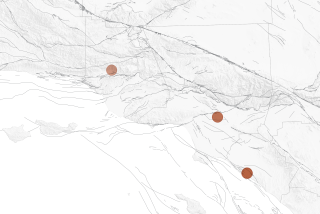Professor Finds Fault With Quake Theories
- Share via
An assistant professor at Chapman University is challenging a widely accepted model for earthquake prediction in an article in Science magazine.
“Instead of revising the old model, maybe it’s time to start thinking of a better one,” said Lisa B. Grant, who holds a doctorate in geology and geophysics.
In her article, which appears in the May 10 edition, Grant wrote that the world’s most accepted model for studying earthquake frequency, “the characteristic earthquake model” developed in 1984, does not always work.
“It’s becoming more and more difficult to explain [earthquake activity] with the characteristic model,” she said.
The theory of the characteristic model holds that large earthquakes tend to recur with characteristic patterns on distinct segments of faults. This pattern of recurrence, which would allow scientists to predict quakes by studying the history of faults, is more complex than hoped, Grant contends.
Recent data from Grant and others suggests that earthquakes and rupture patterns on the San Andreas fault are “variable” rather than “predictable.” They vary in location, displacement of earth and other factors, she said.
Any new theories about this fault are important because it is one of the most studied faults in the world, and findings are regularly applied to faults elsewhere, she said.
Grant, 32, also works as an assistant project scientist at Woodward-Clyde Consultants in Santa Ana, researching seismic hazards in Orange County.
While she is prepared for debate from others in the field, she said, this challenge is not entirely her own.
“I’m not the only one who has said this. I’m the only one who has written it down,” she said.






